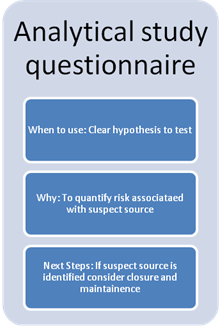Data collection
During an outbreak, data will come from a number of sources that might inform hypothesis
generation regarding a source. Firstly, data from the cases themselves, who will provide
contextual descriptive epidemiological information about where they
might have been and when they got ill. The collection of such information should be
standardised to enable consistent interpretation, and questionnaires are a simple method of
ensuring this. Secondly, any samples taken as a result of environmental
investigations should be recorded, whether from a case's home or a potential community
source. Thirdly, results of microbiological tests on the cases and
environmental samples from potential sources from laboratories will also need to be matched,
where available, to each case source as the tests become available. Fourthly, communication messages can engage local media/doctors to warn the public of
potential outbreak, inform them of suspect sources (where appropriate) and enable case finding thus leading to potential additional cases. If skills exist in the
outbreak control team, then consideration should be given to the
creation of a database to store contextual data in a coherent and robust manner. To facilitate
data interpretation and management, the data should be collected in a standardised format
during the outbreak response. Guidance for potential conventions for formatting key variables
from patients and environmental sources can be found here.
The incubation period for Legionnaires' Disease has been reported to be up to 19 days and has
been discussed elsewhere. Consideration of a pragmatic upper limit of 14
days for case exposure history, is suggested in this toolbox. However, this may vary
operationally from outbreak to outbreak
Case Definitions
It is important to have clear case definitions during an outbreak, to enable comparison and
analysis of cases and thus facilitate the public health response, particularly when working
internationally. Guidance on formulating case definitions in an outbreak can be found here. A case definition could change during an outbreak from being rather broad
at the outset to being more constrained as the outbreak develops and information changes, this
is fine provided that changes are documented. It is critical that the case definition is
explicitly stated when sharing information on disease occurrence.
Questionnaires
Three types of questionnaires could be used during an investigation into cases
of Legionnaires' disease. These service particular needs during a response and are summarised
in the table below. It should be noted that a patient may not be available or capable of
responding to questions. In this case, a suitably proxy - perhaps a partner or family member -
should be identified. Some of the questions, concerning demographic and clinical details, could
be answered by medical staff at the hospital, if possible.
An interview logistics and guidance document is available here



A surveillance
questionnaire, enables reporting and centralisation of case data, and
should facilitate rapid awareness of outbreaks.
Once multiple cases are identified, consideration should be given to a more exhaustive form of
questionnaire. Hypothesis generation is a critical step in an outbreak
situation. By administering an open-ended hypothesis-generating
questionnaire (trawling questionnaire) to some of the first case-patients, the
investigator(s) will attempt to learn about potential exposures to known risk factors. General
guidance is available on creating a hypothesis-generating
questionnaire.
Following a review of the summary information taken from such a process (by
for example a study of the line listing
of an extract from a database) specific hypotheses about the cause of the outbreak
can be formulated. It might be beneficial, in certain circumstances to perform an analytical
study, where these hypotheses will become the basis of a more structured hypothesis-testing questionnaire (see for example the
analytical study protocol).

 Download Page
Download Page

